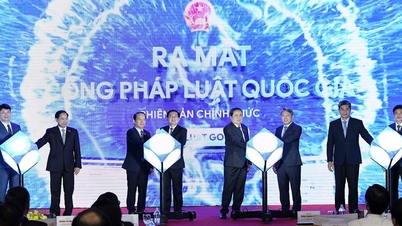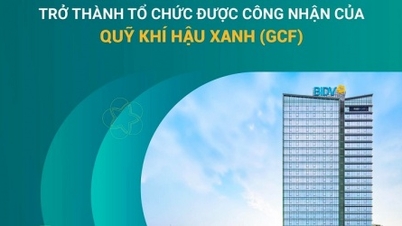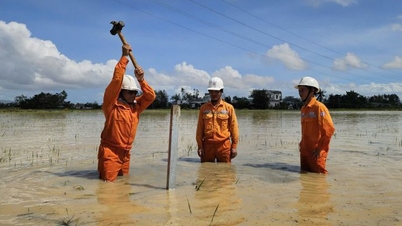The development history of Vietnam as well as the past 40 years of Renovation shows that whenever the whole nation has a unified development mindset, a unified belief to act with determination, no matter how difficult the task is, no matter how big the risk, we will find a way.
At this time, the era of a prosperous, dynamic, and increasingly far-reaching Vietnam is converging. These are the four major resolutions of the Politburo that together create a unified whole of strategic thinking and action for the country's development in the new era, along with the viewpoints, goals, targets, and breakthrough, strong action solutions... stated in the Draft Political Report of the 13th Party Central Committee at the 14th National Congress of the Party. All to realize the burning desire: to write a Vietnamese miracle.
 |
| Strategic technology research in Viettel 's laboratory |
Lesson 3: “Golden key” for 2 100-year goals
The “golden key” to achieving the country’s two 100-year goals gradually took shape when Resolution 57-NQ/TW was issued, creating an innovative ecosystem. Vietnam will not only take shortcuts or get ahead, but is keeping pace with the world with the aspiration to master strategic and core technologies.
Answer the question: Can Vietnam do it?
The amount of work that CT Group has done in 6 months, after the Politburo issued Resolution 57-NQ/TW on breakthroughs in science, technology, innovation and national digital transformation, is equivalent to 2 years. Mr. Tran Kim Chung, Chairman of CT Group, reported this at the Business Meeting with the theme "80 years of businesses accompanying the country" at the end of August 2025, chaired by the Prime Minister.
Of course, what Mr. Chung wanted to say was not just quantity. He said that in August 2025, CT Group was selected by the Indonesian Government as the main partner to develop the low-altitude space economic ecosystem and the UAV industry, serving the fields of energy, agriculture, forestry... Previously, CT Group, together with the Hanoi People's Committee and Gelex Group, started the construction of the 4.0 Innovation Center in Hanoi, built on the platform of AI, Web3 and blockchain...
At the end of June 2025, CT Group launched the first 12-bit chip model, the 200 MSPS model designed by 100% Vietnamese engineers. According to the plan, the chip will be manufactured by TSMC (Taiwan, China) from July, packaged and completed at CT Semiconductor's ATP semiconductor chip factory in November and begin commercialization in December 2025...
“Resolution 57-NQ/TW has made businesses very enthusiastic. We want to answer the question: Can Vietnamese private enterprises develop core technology?”, Mr. Chung shared.
He even said he is nurturing a 20-year program called Vietnamese enterprises go global - advancing to the world through science and technology, innovation and digital transformation. The very ambitious goal is that by 2045, when the country celebrates 100 years of independence, Vietnam will be on par with the world powers, becoming one of the top 10 countries in the world in technology and innovation.
Of course, to do this, the enthusiasm of a few businesses or a few business sectors is not enough.
In the Draft Political Report of the 13th Party Central Committee at the 14th Party Congress, the new growth model was established with science and technology, innovation, and digital transformation as the main driving force. Thus, it can be envisioned that activating the breakthrough strategy for science and technology development, innovation, and national digital transformation as required by Resolution 57-NQ/TW will be the main driving force, forming new value chains associated with innovation, digital transformation, green transformation, energy transformation, structural transformation, and human resource quality transformation, focusing on AI development.
Lieutenant General Tao Duc Thang, Chairman and General Director of Viettel Group, clearly felt the development requirements as well as the space that Resolution 57-NQ/TW opened up. “As soon as I finished reading Resolution 57-NQ/TW, I clearly saw the long-term development opportunities for Viettel. The Resolution has greatly 'untied' the institutional aspect, helping organizations and individuals feel more secure and bolder when investing in testing, mastering, and applying new technologies to create breakthroughs,” Mr. Thang excitedly said.
Viettel immediately jumped into the game with the spirit of “doing it early, doing it quickly, doing it in a breakthrough way and doing it at lightning speed” of Vietnam’s leading technology enterprise. Products with autonomous core technology capabilities were born, such as 5G Open RAN, training simulation systems, communication equipment, etc.
Not only that, Viettel has exported goods worth tens of millions of USD to the Middle East, India, the Philippines...; quickly started construction of the first super-large-scale standard Data Center in Vietnam with a total capital of nearly 1 billion USD in April 2025 and continued to invest 1 billion USD to start construction of two key national projects, An Khanh Data Center and Viettel Research and Development Center, to meet infrastructure requirements and accelerate the implementation of research on assigned national strategic technologies...
“Viettel’s journey to master core technology has no room for hesitation or compromise. Viettel has only one path: to reach the destination with the fastest speed, best quality, and highest responsibility in the spirit of Resolution 57-NQ/TW,” Mr. Thang emphasized.
The foundation of a new growth model
The strong accompaniment and participation of large domestic technology enterprises not only answers the question: "Can Vietnam be technologically autonomous?", but also affirms the power of resonance when Resolution No. 57-NQ/TW is no longer just "the State's job". At the recent conference to review the implementation of Resolution No. 57-NQ/TW, the Central Steering Committee on Science, Technology, Innovation and Digital Transformation development made this statement.
Thanks to that, after 9 months of implementation, Resolution No. 57-NQ/TW has had positive changes, achieving important initial results. The work of building and perfecting institutions and policies has been promoted, removing inherent bottlenecks, creating an increasingly synchronous legal corridor; digital infrastructure has been gradually shaped; digital platforms, applications, and services serving people and businesses have initially had substantial changes.
However, many shortcomings, limitations, difficulties and challenges from practice have appeared.
Mr. Kelly Wong, General Director of VNG Corporation, analyzed that the missing factor is a continuous and multi-layered capital flow, suitable for each stage of development of a technology enterprise. This can include venture capital in the testing stage, growth investment capital to help expand the company and public market capital IPO to help increase transparency and corporate governance capacity.
“When there is a clear 'capital exit', venture funds and private investment will be more confident in investing. Domestic investors will have the opportunity to participate in the success stories of Vietnamese startups. At the same time, an optimal and transparent IPO mechanism will attract more abundant international capital flows, helping to form international technology enterprises, leading the market, creating core technologies as Resolution 57-NQ/TW expects,” said Mr. Kelly Wong.
Meanwhile, from Viettel's experience, Mr. Tao Duc Thang mentioned the support from the Government in its role as a gateway for businesses to access the world's high technology. Depending on the field, support can come from many aspects, from budget, technology, working conditions... to market, ecosystem. Especially, for start-ups with limited resources, output support will help form a strategic technology ecosystem.
“This is very important, because strategic technology does not necessarily create strategic products. Having strategic products does not necessarily form a strategic industry. But if we build a strategic technology ecosystem, from which strategic products are created, a diverse ecosystem will be formed, forming the foundation for a sustainable strategic industry as proposed in Resolution 57-NQ/TW,” Mr. Thang proposed.
From a macro perspective, Dr. Nguyen Quan, Chairman of the Vietnam Automation Association, emphasized three things that need to be done immediately.
Firstly, ministries, branches and localities must immediately select technologies from the list of 11 key technology groups, from which they place orders with research institutes, universities and scientists.
Second, it is necessary to immediately establish a Science and Technology Development Fund and a Venture Investment Fund at the ministerial and provincial levels and operate them according to a public, transparent and effective mechanism.
Third, issue policies to reward scientists and mechanisms to commercialize research results to turn "scientific seeds" into "industrial fruits".
Minister of Science and Technology Nguyen Manh Hung is even calculating a policy system to support output for strategic products, through government procurement and allocating 10-20% of funding from the Science and Technology Development Fund. In addition, there is a mechanism of State support vouchers for technology innovation enterprises, in which, type 1 mechanism is for enterprises to hire research organizations to improve processes and products; type 2 is for enterprises to buy and test new domestic technologies. Mr. Hung also suggested that the Government have a mechanism to assign and order enterprises to make digital platforms for nationwide use...
Obviously, the problem here is the institution that promotes the participation of all parties, including the State and enterprises, in innovation and development of science and technology.
General Secretary To Lam affirmed that removing institutional bottlenecks must be the top priority. These include data exploitation institutions to break down “separatist thinking”; intellectual property institutions, commercialization of research results to connect institutes and schools with the market; public-private partnership institutions to mobilize social resources… and institutions strong enough to protect cadres who dare to think, dare to do, dare to take responsibility for the common good.
At that time, Resolution 57-NQ/TW will truly be the "golden key" to achieving growth targets, including two 100-year goals: becoming a modern industrialized developing country with high average income by 2030 and a developed country with high income by 2045.
Vietnam will become strong, standing shoulder to shoulder with the world powers on the basis of autonomy and self-reliance in science and technology development. This is also the position for Vietnam to step into integration with the aspiration to create global values together.
The National Assembly has passed the Law on Science, Technology and Innovation; the Law on Digital Technology Industry. Eight laws related to science and technology have been completed and will be submitted to the National Assembly for consideration and approval in the coming time.
The Government has issued 16 decrees and 1 resolution.
The Government also issued Decision No. 1131/QD-TTg promulgating the List of Strategic Technologies and Strategic Technology Products.
(To be continued)
Source: https://baodautu.vn/ky-nguyen-moi-va-khat-vong-ky-tich-viet-nam---bai-3-chia-khoa-vang-cho-2-muc-tieu-100-nam-d423097.html




![[Photo] Cutting hills to make way for people to travel on route 14E that suffered landslides](https://vphoto.vietnam.vn/thumb/1200x675/vietnam/resource/IMAGE/2025/11/08/1762599969318_ndo_br_thiet-ke-chua-co-ten-2025-11-08t154639923-png.webp)






































![[Video] Hue Monuments reopen to welcome visitors](https://vphoto.vietnam.vn/thumb/402x226/vietnam/resource/IMAGE/2025/11/05/1762301089171_dung01-05-43-09still013-jpg.webp)































































Comment (0)